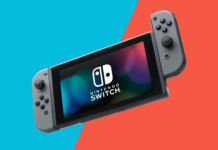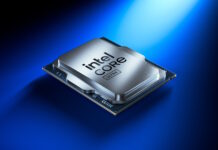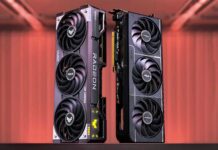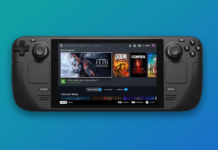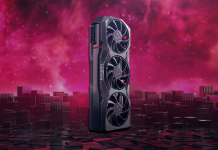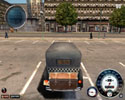Today we have a mixed bag of graphics cards to offer. We usually try to make roundups where we review cards based on the same chip, or at least cards in the same price range. However, today we’ve got some cards from here and there and we decided to put everything in one review.
Today we have a
mixed bag of graphics cards to offer. We usually try to make roundups where
we review cards based on the same chip, or at least cards in the same price
range. However, today we’ve got some cards from here and there and we decided
to put everything in one review.
The
manufacturers in today’s review are Gainward, ATi and Albatron and the
cards we offer are: All In Wonder Radeon 9600 Pro, Radeon 9600XT,
GeForce FX 5600 Ultra, GeForce FX 5700 Ultra and two different GeForce
FX 5900’s.
It’s not
that much to discuss, right? Let’s take a look at the GeForce FX 5700
Ultra, the new middle range card from nVidia.
Gainward’s 5700 Ultra just arrived from the manufacturer therefore we don’t have the final box. Fact is that they changed the name on the card just as we got it so this is some hot stuff.
Gainward FX PowerPack! 960 Golden Sample

|
|
Chip:
|
NV36
|
|
Manufacturing process:
|
0.13-micron
|
|
Transistors:
|
~80 mil.
|
|
GPU-speed:
|
500
MHz
|
|
Memory speed:
|
1000 MHz / 15.6 GB/s
|
|
Pixel Shader:
|
2.0
|
|
Vertex Shader:
|
2.0
|
|
Pixel Pipelines/Pixel Fillrate:
|
4
/ 2000 MP/s
|
|
TMU’s/Texel Fillrate:
|
1
/ 2000 MT/s
|
|
RAMDAC:
|
(2)
400 MHz
|
|
Memory size:
|
128
MB
|
|
Memory type and interface:
|
128-bit,
DDRII
|
|
I/O connections:
|
2x DVI-I, S-Video
|
|
Accessories:
|
DVI-VGA-adapter, ATX-Y-kabel, S-Video-composite adapter
|
|
Software:
|
Expert tool
|
|
Fullversion software:
|
WinDVD 4
|
|
Estimated price:
|
€200
|
Gainward delivered the first 5700-card to us at NordicHardware. In ordinary order they haven’t settled with nVidias reference clock frequency and increased the speed from 475/900 to 500/1000.
If we continue to look at the cards specifications we notice the return of DDR II. Further more we can tell you that this card is for 5600 Ultra that 5900 Ultra was for 5800 Ultra. In other words this isn’t just a “overclocked” 5600 Ultra we have here. nVidia have been working to improve the performance with Pixel Shader 2.0. However the card is still of the same type 4×1/2×2 “hybrid” as its forerunner.
|

Front
|
|

Rear
|
The flame from Gainward 5600 Ultra is back but with a different appearance. The new cooler is more genuine and reminds of the one we can see on Gainwards 5900SE. The DDR-II-memory is equipped with heatsinks which has to be considered as a must when the memory gets very warm. The cooling is relatively silent, more silent that 5600 Ultra for example.
One unusual thing this card can brag with is Dual DVI. In my opinion this is a much cleaver choice than dual VGA or one VGA and one DVI because you can convert DVI to VGA but not the other way around.
The card is longer than its forerunner and measures the same as a FX 5900. If this is unique for Gainward or if this applies to all 5700 Ultra we don’t know because this is the only 5700 Ultra we tested.

Accessories
The accessories aren’t very impressive. WinDVD 4 and all the cables/adapter you need is all that’s included.
It has been some time since we reviewed a card from Albatron and as we can see they have changed their design
slightly.
|
Albatron Gigi GeForce FX 5600 Ultra

|
|
Chip:
|
NV31
|
|
Manufacturing process:
|
0.13-micron
|
|
Transistors:
|
~80 mil.
|
|
GPU-speed:
|
400
MHz
|
|
Memory speed:
|
800 MHz / 12.5 GB/s
|
|
Pixel Shader:
|
2.0
|
|
Vertex Shader:
|
2.0
|
|
Pixel Pipelines/Pixel Fillrate:
|
4
/ 1600 MP/s
|
|
TMU’s/Texel Fillrate:
|
1
/ 1600 MT/s
|
|
RAMDAC:
|
(2)
400 MHz
|
|
Memory size:
|
128
MB
|
|
Memory type and interface:
|
128-bit,
DDR-SDRAM
|
|
I/O connections:
|
VGA,
DVI-I, S-Video
|
|
Accessories:
|
DVI-VGA-adapter,
S-Video-composite adapter
|
|
Software:
|
5in1 Demo CD (AOWII, Max Payne, Zax, Beambreaker and Rally Trophy)
|
|
Fullversion software:
|
Duke
Nukem Manhattan Project and WinDVD Creator
(including WinDVD)
|
|
Estimated price:
|
€160
|
Albatrons Gigi 5600 Ultra is a relatively “ordinary” 5600 Ultra. The clock frequency,
outputs etc. follows the reference design exactly. In the software package we
find a lot of demos and a full version of the game Duke Nukem Manhattan Project. Admittedly I am no game critic but to say that this game is
one of 3D realms not so good ones would be to express it fairly nice. The demo
CD with the title “Game Pack” contains five demos that admittedly
all of them is quite old but should bring pleasure for an hour or two.
Included is also WinDVD Creator which helps to create your own media-discs and
furthermore play DVD etc.
|

Front
|
|
|
 Rear Rear
|
|
On
this second revision of Albatrons 5600 Ultra there
is a new cooling solution. I’m sorry to say that the fan causes a very
high frequent annoying sound. Besides that the cooling does as it should and
keeps the card cool.
As
you can see it’s a pretty boring green PCB furthermore it looks quite
destitute on the left side for some reason. Perhaps you could have pushed
the components more together and make it a little shorter.
 Accessories
Accessories |
Albatron offers a pleasant
accessory package. One demo-CD with five games, one full version game and
WinDVD Creator and all the cables/adapters you will need on a DVI-VGA adapter .
This page is dedicated to two different 5900-cards from Albatron
Albatron GeForce FX 5900 PV/5900 Turbo

|
|
Product:
|
5900 PV / 5900 Turbo
|
|
Chip:
|
NV35
|
|
Manufacturing process:
|
0.13-micron
|
|
Transistors:
|
~125 mil.
|
|
GPU-speed:
|
400
/ 410 MHz
|
|
Memory speed:
|
850 MHz / 26.6 GB/s
|
|
Pixel Shader:
|
2.0
|
|
Vertex Shader:
|
2.0
|
|
Pixel Pipelines/Pixel Fillrate:
|
4
/ 1600 / 1640 MP/s
|
|
TMU’s/Texel Fillrate:
|
2
/ 3200 / 3280 MT/s
|
|
RAMDAC:
|
(2)
400 MHz
|
|
Memory size:
|
128
/ 256 MB
|
|
Memory type and interface:
|
256-bit,
DDR-SDRAM
|
|
I/O connections:
|
VGA, DVI-I, S-Video (S-Video In/Out, Komposit In/Out)
|
|
Accessories:
|
ViVo-dongle, S-Video-cable, Kompositcable and DVI-VGA-adapter
|
|
Software:
|
5in1 Demo CD (AOWII, Max Payne, Zax, Beambreaker and Rally Trophy)
|
|
Fullversion software:
|
Duke Nukem Manhattan Project, PowerDVD XP and PowerDirector Pro ME
|
|
Estimated price:
|
€265 / €350
|
The two 5900-based cards from Albatron is very much the same: we can summarize it like this: “Turbo”-version has 128 MB more memory, 10 MHz faster core, one heatsink on the back och the card and cost a thousand SEK more.
|

Front
|
|
One thing that Albatron is proud over is “WiseFan”. As you can see the card has three fans but the trick is that only two fans are active at a time. The point is quite simply that if one fan stops working the inactive one takes over. We tried this by sticking in the finger in one of the fans. The third fan then started.
A function that I gladly would have seen is that you could run all tre fans for maximum cooling. When it comes to sound level on the card the fun thing is that it’s even more silent than Albatrons own 5600 Ultra which is a good thing.
|

5900 PV rear
|
|
|

5900 Turbo rear
|
|
On the back of the cards it’s only the big heatsink on the Turbo-card that separates the two.

A
ccessories
The accessory package feels generous on this card and we get everything we think you should include with a card: DVD-software, video capture-software and all the cables/adapters, one game etc. That the cards have Video In is a plus.
Better late than never, here comes our first view on Radeon 9600 XT
Radeon 9600 XT

|
|
Chip:
|
R360
|
|
Manufacturing process:
|
0.13-micron LowK
|
|
Transistors:
|
~60 mil.
|
|
GPU-speed:
|
500 MHz
|
|
Memory speed:
|
600 MHz / 9.4 GB/s
|
|
Pixel Shader:
|
2.0
|
|
Vertex Shader:
|
2.0
|
|
Pixel Pipelines/Pixel Fillrate:
|
4
/ 2000 MP/s
|
|
TMU’s/Texel Fillrate:
|
1
/ 2000 MT/s
|
|
RAMDAC:
|
(2)
400 MHz
|
|
Memory size:
|
128 MB
|
|
Memory type and interface:
|
128-bit,
DDR-SDRAM
|
|
I/O connections:
|
VGA, DVI-I, S-Video
|
|
Accessories:
|
–
|
|
Software:
|
–
|
|
Fullversion software:
|
– (Half-Life 2)
|
|
Estimated price:
|
€150
|
Because this is only a reference card and that we already did a review on what’s new in 9600XT we won’t dwell things. Still there are a few things we like to mention before we go on. As you can see it is longer than GeForce FX 5700 Ultra and still we didn’t pick the cheapest card we found (1650 SEK). The cheapest 5700 Ultra we found cost exactly 2000 SEK. Fact is that it’s even cheaper than the cheapest 5600 Ultra we can find and as you can recall the 5600 Ultra got beaten by Radeon 9600 pro so 9600 XP beats it even more. When we include Half Life 2 in our calculation everything gets more impressing. Sadly enough Valve/ATi/Vivendi messed it up so Half Life 2 is delayed and there is no estimated date on when it will be finished. A coupon which will give you Half Life 2 will be included in all Radeon 9600 XP-packages. Until that the coupon applies for a package with a lot of other games from Valve so you won’t be deceived after all.
A rather united press congratulated Radeon XT when it was released last month. Personally I’m a little doubtful to congratulating the card and have a hard time to understanding what’s so amazing when I compare it to 9600 Pro. If they only had raised the memory-clock frequency a little (500-100 MHz would have been enough) I surely would have been more positive to the card. I personally think that ATi in public is a little conservative with memory speeds. Now over to All In Wonder Radeon 9600 Pro
The Mid end-card All In Wonder Radeon 9600 Pro, which can do everything and a little more. 😉
Radeon 9600 XT

|
|
Chip:
|
R360
|
|
Manufacturing process:
|
0.13-micron LowK
|
|
Transistors:
|
~60 mil.
|
|
GPU-speed:
|
400 MHz
|
|
Memory speed:
|
600 MHz / 10.2 GB/s
|
|
Pixel Shader:
|
2.0
|
|
Vertex Shader:
|
2.0
|
|
Pixel Pipelines/Pixel Fillrate:
|
4
/ 1600 MP/s
|
|
TMU’s/Texel Fillrate:
|
1
/ 1600 MT/s
|
|
RAMDAC:
|
(2)
400 MHz
|
|
Memory size:
|
128 MB
|
|
Memory type and interface:
|
128-bit,
DDR-SDRAM
|
|
I/O connections:
|
VGA, DVI-I, S-Video
|
|
Accessories:
|
–
|
|
Software:
|
–
|
|
Fullversion software:
|
– (Half-Life 2)
|
|
Estimated price:
|
€222
|
All In Wonder Radeon 9600 Pro is, when it comes to 3d, a Radeon 9600 Pro but with 50 MHz faster memory. Still it’s not only the 50 MHz increase on the memory that makes this an interesting product. What this card has to boast with is its Video In and TV-turner abilities. Except for these functions this card has even MORE to offer.
 ViVo-dongle
ViVo-dongle
|
AIW Radeon 9600 Pro is the first AIW-card that supports multiple monitors. Dual monitor support is something AIW-fans wanted for some time now and finally ATi does something about it. What already is a feature rich series has been even richer.

Remote Wonder II
|
The remote control has also been renewed since last time. The new control has a little more pleasant look, offers more programmable buttons and even better range. 19 metres is what should be enough for most people.
Last but not least we have two new functions on the card that are clearly of large interest:
Radio tuner: AIW 9600 Pro is by me the first graphic card with built-in radio turner. The functionality is as good as for the TV-turner and you can schedule recordings of radio shows etc. The sound quality is good and works as it should. Surely a nice finesse.
CD/DVD-recording: 9600 Pro is the first AIW-variant with build-in support for CD/DVD-burning. This function is very welcome and makes it easy to burn VCDs or DVDs from your recorded movies.
If I should complain on anything it is that ATi still haven’t build-in support for SVCS in its media player. (Funny enough their CD-burning program has support for SVCD, furthermore, it has finished profiles for SVCD-recording.)
The card cost roughly 250€ in store and then in most cases the game Half Life 2 will be included. In my eyes it’s worth the price even though I would like to see that the cards were 20€ cheaper. If it’s worth the price for you is hard to decide, how bad do you want all of its features? (If you’re not after the AIW function then this isn’t a card you should look for)
The test system
remains unchanged.
|
Test system
|
|
Hardware
|
| Processor: |
AMD Athlon XP 3200+ (400) Mhz
|
| Cooling: |
Corsair HydroCool 200
|
| Moderkort: |
ABIT NF7S 2.0
(nForce2 400 Ultra)
|
| RAM: |
768 MB DDR333 @ 2-5-2-2 timings
3x 256 MB Corsair TWINX512-3200LL DDR-SDRAM
|
|
Graphics cards:
|
Gainward GeForce FX 5700 Ultra (128 MB, 500/1000) – €200:-
Albatron GeForce FX 5600 Ultra (128 MB, 400/800) – €160:-
Albatron GeForce FX 5900 PV (128 MB, 400/850) – €265:-
Albatron GeForce FX 5900 Turbo (256 MB, 410/850) – €350:-
nVidia GeForce FX 5700 Ultra (128 MB, 475/900) – €175:-
ATi Radeon 9600 Pro (128 MB, 400/600) – €130:-
ATi AIW Radeon 9600 Pro (128 MB, 400/650) – €222:-
ATi Radeon 9600 XT (128 MB, 500/600) – €150:-
ATi Radeon 9800 (128 MB, 325/580) – €230:-
ATi Radeon 9800 Pro (128 MB, 380/680) – €265:-
|
|
HDD:
|
120 GB Western Digital Caviar 7200 RPM Special Edition (8 MB cache)
|
|
Soundcard:
|
Creative
Soundblaster Audigy 2 ZS Platinum Pro
|
| PSU: |
Nexus NX-3000 300W
|
|
Ethernet:
|
D-Link DFE-530TX 10/100
|
|
Software
|
| Operating system: |
Windows XP Professional (Service Pack 1 + updates)
|
| Video drivers: |
nVidia: Forceware 52.16
ATi: Catalyst 3.8
|
| Other drivers: |
nVidia ForceWare UDA Chipset Drivers v3.13
|
|
Benchmarking program:
|
Unreal Tournament 2003 (v2225)
Quake 3: Arena (v1.32)
Tomb Raider: Angel of Darkness (v.49)
Star Wars Jedi Knight: Jedi Academy (“1.0”)
Battlefield 1942: Secret Weapons of World War II (demo “1.0”)
Comanche 4 (demo “1.0”)
WarCraft 3: Reign of Chaos (demo “1.0”)
Counter-Strike (v1.6)
Mafia: City of Lost Heaven (v1.1)
Halo (v1.02)
Max Payne 2: The Fall of Max Payne (v1.01)
|
We have eleven
games and ten cards to test. In other words, we have 110 performance results
to plow through. We have picked cards that are in about the same price range.
The only card we have missed is one that can team up with Albatrons 5900 Turbo.
The one closest to it would be the Radeon 9800 PRO 256 mb, but we only have
place for ten cards in our graphs, so we gave the job to Radeon 9800 PRO 128
mb.
We have used the two latest official drivers from ATi and nVidia.
In the review,
you will read a couple of different expressions and abbreviations, if you
are not related with them our suggestion is that you take a look at the list
below. The same list explains some other expressions that are used specifically
for this review.
- AA,
FSAA (Full Scene Anti-Aliasing) – Edge smoothing (Reduces angularity
in 3D graphics); all modern graphics cards should handle AA/FSAA in some
form. AA can be applied in different strengths; 2X, 4X, 6X and so on. The
more the better.
- AF,
Aniso (Anisotrophic Filtering) – Antistrophic texture filtering
(Increases the sharpness in texture/surfaces in 3D-Graphics); all modern
cards should handle AF in some form.
- App
(Application Preference) – If something is marked with this suffix it means
that we have let the game handle the AF instead of setting it in the graphics
cards control panel.
- Trilinear
– Two different types of texture filtering that either is used on their
own or combined with anisotrophic filtering. The highest quality is reached
by a combination of trilinear and anisotrophic filtering. At the time, trilinear
filtering is the standard in all games released and is seen as a minimum
for acceptable quality with today’s measurements.
- Aliasing
– Graphical artifacts that comes from insufficient Information/Precision.
It’s often because of “dancing” pixels on either the sides or within textures.
By using AA and AF you can reduce Aliasing.
If you find anything
above unclear, feel free to e-mail questions to the address you will find
at the top of the page. (Please remember that we are not an idealistic support
service, hence we recommend you to drop a line in our forums and to the reteller
where you bought the product for support.)
It has surfaced
a good deal of information about irregularities concerning picture quality
in both ATi’s and nVidia’s drivers. One piece of news in Forceware 52.16 from
nVidia is that they no longer support real trilinear filtering. Admittedly,
we haven’t considered this as a noticeable problem, but it’s far from a plus.
The major problem we have encountered is antistrophic filtering in combination
with pixel shaders. Here, nVidia seems to have done something weird- maybe
it’s a bug, because the combination of these two named functions cause a lot
of aliasing which hasn’t been there before. ATi, on the other hand, has been
accused of cheating in Halo, UT2003 and Aquamark 3. Regarding the latter application,
I am uncertain as I haven’t tested it myself, but in UT2003, certain high-detail
textures is told to have lower quality, which also applies to Halo. Fact is
that we haven’t been able to find these irregularities even though we have
dug around in the games for a couple of hours. None of our colleagues on other
hardware sites have found nothing of value either.
In all the tests,
we use the resolution 1280×1024 with 4x AA (Full Scene Anti-Aliasing) and
8x AF (Anisotropic Filtering, i.e. advanced texture filtering) if nothing
else is stated. We have chosen the resolution 1280×1024 (or 1280×960 in those
games where 1280×1024 aren’t available) because this is a reasonable setting
when it comes to performance but also because most of our readers probably
have monitors which are capable of this resolution.
In those tests where 1280×1024-4xAA/8xAF has showed to be too demanding, we
have first chosen to lower the resolution to 1024×768 and lowered or shut
off AA/AF until a playable level of performance is reached.
After we have
made the actual performance tests, we have spent approximately 30 minutes
(in some cases a lot more than that) sitting down and playing the game
seriously to see how it works in practice.
|
Quake 3: Arena
|
We test the Open GL game Quake 3 to evaluate the
performance in somewhat older titles. A large amount of titles are
build on the “Q3” engine. We use ourselves of the test demo four.dm_67
in the benchmark tool Q3Bench.
|
Game engine: |
Open GL (DX7 class)
|
Pixel Shaders: |
No
|
Vertex Shaders: |
No
|
Among the highend
cards (5900/9800), nVidia has a great performance overhead which we have seen
in our latest reviews. The smaller guys are quite similar and it is really
only 5600 Ultra that falls behind.
Subjective
analysis: Even the 5600 Ultra manages to keep up here. The real action
filled moments are of course much smoother on the more expensive cards, but
in the whole, the difference in the gaming experience is far from as dramatical
as the procentual differences seen above. When it comes to image quality we
hardly have the time to see any mentionable differences in this action game.
|
Unreal Tournament 2003
|
UT2003 is a DirectX 8 game which push the graphics cards
quite hard with large textures and high numbers of polygons etc. A
numer of games are built on this engine. We use the more graphics
demanding flyby test. We test the game on the level Inferno.
|
Game Engine |
Direct3D (DX8.1)
|
Pixel Shaders: |
Yes (1.1
and 1.4)
|
Vertex Shaders: |
Yes (1.1)
|
In UT2003, it’s
ATi’s turn to shine. 9600 XT delivers performance which is in between 5700
Ultra and 5900 – simply an impressive result.
Subjective
analysis: To play UT2003 with AA/AF a highend card is required. Not
even 5900 with 256 MB manages terribly good in this test. ATi is the obvious
choice according to the diagram. Of course, this also applies for image quality.
|
WarCraft 3: Reign of Chaos
|
WarCraft 3 is one of the years best selling
games which makes it a good test object. Despite that the graphics
lacks extra ordinary technique the game is quite demanding. The
performance tests are done on the first level in the WC3 demo with
help from FRAPS.
|
Game engine: |
Direct3D (DX8.1)
|
Pixel Shaders: |
No
|
Vertex Shaders: |
No
|
2 – 1 for ATi
since Warcraft seems to work better on the Radeon cards.
Subjective
analysis: The procentual differences may be quite large but the fact
is that the game runs as smooth on a 9800 XT as on a 5700 Ultra. The only
card that couldn’t manage now and then was 5600 Ultra. When it comes to texture
filtering it doesn’t matter as much but ATi has as usual the overtake when
it comes to AA quality.
So far, we haven’t
seen any direct surprises, but with eight games left to test much may still
happen.
|
|
Mafia: The City of Lost Heaven
|
|
Mafia is built on an own developed Direct3D engine and
uses large numbers of relativly low quality objects to in such a way
create a large level of detail. There are similar game engines in for
example the GTA series. To measure the performance we have run Free
Ride’s first level and used FRAPS.
|
Game engine:
|
Direct3D
(DX8.1)
|
Pixel Shaders:
|
Yes (1.1)
|
Vertex Shaders: |
Yes
(1.1)
|
The Radeon gang
rules merciless in Mafia. The slowest Radeon card is faster than the fastest
GeForce card. What more could we say? What is interesting to see is that 5700
Ultra is over 40 per cent faster than its predecessor. Probably, the shader
improvements in the 5700 chip has something to do with it.
Subjective
analysis: All Mafia bosses has a Radeon in the computer, no talk
about it. It looks nicer and plays smoother on Radeon, simple as that. But
the differences are actually not that great as shown in the diagram. For example,
despite the 5600 Ultra’s low fps it still works OK on that card.
|
|
Comanche 4
|
|
Comanche 4 is built on an own Direct3D engine which uses
Pixel and Vertex Shaders together with high resolution textures. The
game is one of the few which really "needs" a graphics card with 256 MB.
We test it with the downloadable demo’s benchmarking tool.
|
Game engine:
|
Direct3D
(DX8.1)
|
Pixel Shaders:
|
Yes (1.1)
|
Vertex Shaders: |
Yes (1.1)
|
nVidia has the
overtake in Comanche 4 and 5700 Ultra impresses with performance that
challenges Radeon 9800. Radeon 9600 XT on the other hand does not even have
the strength to bypass FX 5600 Ultra.
Subjective
analysis: Comanche plays OK on all the cards down to GeForce FX 5700
Ultra. ATi has a superior overtake in AA quality since there is a high contrast
at edges in the game (for example mountains that meet light blue sky).
|
|
Counter-Strike
|
Counter-Strike doesn’t need a direct presentation. Though it’s said
that the new 1.6 version is more demanding than the predecessor and
therefore we chosed to test that. The test consists of a demo of the
level cs_havana with 18 players.
|
Game engine:
|
Open GL (DX6
class)
|
Pixel Shaders:
|
No
|
Vertex Shaders: |
No
|
Counter-Strike
offers funny numbers. So far we have only tested real fast cards in CS where
the performance has been more or less identical between all the cards, but
here’s a clear difference. One thing that really surprises is how much faster
a 9600 XT is compared to a 9600 Pro. The three cards which are placed last
stutter noticeably when there are smoke grenades on the screen with AA activated.
Beyond that, CS is one of the few games where we can see that nVidia and ATi’s
respective cards are actually very similar.
Subjective analysis: CS runs smooth on all cards down to Radeon 9600
XT as said. The differences between ATi and nVidia here is in image quality
and ATi leads there. Not a big lead but here the margins decide.
Six evaluations
are complete and five remain.
|
|
Battlefield
1942:
Secret Weapons of WWII
|
Battlefield 1942, developed by Swedes, is still a very
popular online game and because of this it feels even more important to
test it. Once again we use the FRAPS tool and evaluate the downloadable
demo.
|
| Engine: |
Direct3D (DX8.1)
|
| Pixel Shaders: |
No
|
| Vertex Shaders: |
No
|
The
Radeon cards are a lot faster in Battlefield, there’s no doubt about
it. Playing BF with AA/AF using a 5700 Ultra or lower is something we
would never recommend.
Subjective
analysis: Ask grandpa what graphics card was being used in the battlefield
of the ’40s and he will of course reply that it was a Radeon. nVidia suffers
from a quite horrible mouse lag in a couple of games when AA is enabled and
this game is one of them.
|
|
Tomb
Raider:
Angel of Darkness
|
Tomb
Raider is the first commercial game to use 100% of DirectX 9.0 for its
graphics and thereby making it an interesting test object. The test is
run with the integrated tool’s latest patch. The Prague3a level was
selected for this test.
|
| Engine: |
Direct3D (DX9)
|
| Pixel Shaders: |
Yes (1.1, 1.4 and 2.0)
|
| Vertex Shaders: |
Yes (1.1
and 2.0)
|
We
mentioned before that nVidia has fixed their pixel shaders a bit. In
Tomb Raider it is obvious to us that they have done a really terrific
job even if the raised clock frequences of course also contributes to
the huge difference in performance. But, it isn’t even close enough for
nVidias card to be given a shot to challenge the Radeon when we notice
that a 9600 XT is even faster than a 5900.
Subjective
analysis: With the settings we use, Tomb Raider is ridiculously slow for all cards except
the Radeon 9600 XT and better. Although, the 5900 has an average fps that
reminds you of 9600 XTs but the fps instability of the 5900:s are far deeper
than with the ATi cards, which in turn transforms this game into something
that reminds you of a slideshow, now and then. For short: “ATi makes the board
with which it’s meant to be played”… or something like that.
Except from that, we don’t see any obvious differences in image quality
with the settings we use.
|
|
Star
Wars Jedi Knight:
Jedi Academy
|
Jedi
Academy is the successor of the popular Jedi Knight II. It is built
using the Q3 engine, but it has got among other things very
high-resoluted textures and more light effects. We have tested a
customised recorded demo of the Traspir level where we met 7 enemies.
|
| Spelmotor: |
Open GL (DX8.X?)
|
| Pixel Shaders: |
Yes? (1.x?)
|
| Vertex Shaders: |
Yes? (1.x?)
|
After
ATi humiliated nVidia two times in a row, it is now time for
nVidia to flex their muscles in Jedi Academy. ATi are outperformed
totally and nVidia squeezes them in every price level.
Subjective
analysis: With a light saber or just an extreme hairgrowth and heated
voice, you should choose nVidia. This is one of the few things that Sith and
Jedis can come to an agreement about. To be honest, the differences in Jedi
Academy, just like in Mafia, is somewhat fussy. The game runs perfect, no
matter the numbers, and no matter if you use nVidia’s or ATi’s card.
New this
time is Halo, developed by Bungie/Gearbox. The game was released for
the Xbox and was later “converted” to the PC platform. In the PC version
there is to some extent, DirectX9 functionality and therefore
also yet another “new generation game”, if you know what I mean.
|
|
Halo:
Combat Evolved
|
|
Halo is
probably what you would call to be the first really price worthy
DirectX9 game, which of course make it very interesting. We are testing
the performance by adding the command line -timedemo that measures
the performance in the “cut scenes”. This gives you a decent view of how
the card will perform in the game.
|
| Spelmotor: |
Direct3D (DX9)
|
| Pixel Shaders: |
Yes (1.1, 1.4 and 2.0)
|
| Vertex Shaders: |
Yes (1.1)
|
ATi tops
the list again, but 5700 Ultra shows once again that it is a far better
card than its predecessor when we are talking pixel shader intensive
games. We don’t know what will happen to the 9800 non-Pro in this test,
but the performance is tremendously lots worse than 9800 Pro.
Subjective
analysis: The performance in Halo is quite similar between the graphics
cards, if you stay within the same price level. nVidia have got some problems
with aliasing on some surfaces (those which use pixel shaders to be exact)
when anisotropical filtering is enabled. If you’re going to play Halo with
all the eye candy enabled (and without aliasing) I highly recommend buying
for instance the Radeon 9800 Pro or even 9800 XT since it’s extremely demanding
with graphics. How this could happen when the game worked alright on a kind
of worthless PC called Xbox is something that will remain a riddle for now…
|
|
Max
Payne 2: The Fall of Max Payne
|
|
The sequel to
the extremely popular Max Payne game developed by the Finnish company
Remedy. We are testing the performance in this game by benchmarking it
using FRAPS in something called “cut scene”. The game uses the
spectacular Havok physics engine and Pixel Shaders among other things.
|
| Engine: |
Direct3D (DX9)
|
| Pixel Shaders: |
Yes (1.1 and 1.4)
|
| Vertex Shaders: |
Yes (1.1)
|
Max
Payne is yet another game working a lot better with ATi’s card. Radeon
9600 XT is more than 20 % faster than Gainward’s overclocked 5700
Ultra, for instance. Apparently, the game also uses shaders that are
advanced enough (Pixel Shader 1.4 and Vertex Shader 1.1) so the
architectural differences between 5600 and 5700 are going to get
noticed.
Subjective
analysis: No matter the intensive fights taking place in this game,
the fps does not fail critically for any of these cards except with the FX
5600 Ultra which clearly expresses: this game is extremely well-programmed.
To get the really super comfortable gameplay in all moments you would need
something close to the performance you get out of 5800/9700, but you will
do well with 9600 Pro or 5700 Ultra as well. However, in the end, ATi wins.
Summarizing
words about the gaming tests |
We have a
bowl of soup with mixed contents today: everything from 5600 Ultra to
5900 “Turbo”.
This
review’s two new things in the mid end segment is Radeon 9600 XT and
GeForce FX 5700 Ultra. In our latest test roundup it looks like 9600XT
has advantages over the others and that not even Gainward’s
“overclocked” 5700 Ultra will manage to intercept the 9600 XT in more
than four out of a total of eleven tests. The results are
impressing with the 9600 XT. No matter that the card have only 60% of
the Gainward card’s bandwidth, it somehow manage to outperform everyone
else in the majority of these massive tests.
FX 5600
Ultra begins to feel somewhat boring even if nVidia upgraded the card
to have 50 MHz faster core shortly after it was released. In our eleven
tests the card shows up at the end of the list in eight of the tests,
which clearly states what kind of performance this card will actually
give you.
The pair
of 5900-based cards from Albatron gets defeated by “ATi-chipped” cards
in seven out of eleven tests. That is, with the same thing as
between 9600XT and 5700 Ultra. We also notice that 5900 Turbo
isn’t any noticeably faster than 5900 PV even with the presence of its
extra 256 MB and 10 MHz.
Radeon
9600 XT gives you good performance if you think about what price level
it belongs to, and kicks the “ordinary” 5700 Ultra’s behind in eight of
our tests and on the same level in another one. It’s really an
overwhelming outperformance if you compare to the challenger from
nVidia.
AIW 9600
Pro doesn’t really deliver all that much performance “price
level”-wise. But All In Wonder cards are not exclusively about
performance when there are other things in mind than just performance
that sets the price high in this case. Although, it is nice to see that
the card is even faster than the ordinary 9600 Pro and at the same time
gives 5700 Ultra a tough challenge.
The time
has come to finish this off, but before we end it we are going to take
a look at how they perform when overclocked.
None of the retail cards
in this review impress since they can’t even reach a 15% overclock on either
core or memory.
Since Gainward
already supplies a card with higher clock frequencies than nVidia’s reference
design you can’t clock much higher. Fact is that their Enhanced Mode touches
the limit.
What impresses
most is instead the Radeon 9600 XT. How about a core on 625 Mhz? This is
probably the first time we’ve been able to run a core in sync with a DDR-memory’s
effective clock frequency (which we did by the way mostly for fun just to
see if there was to give any extra performance, but there was none). AIW
9600 Pro also succeed with a very good core-overclock but the memory isn’t
ready for more than it’s standard frequencies.
Otherwise,
we get pretty good results with the Albatron GeForce FX 5600 Ultra and Albatron
GeForce FX 5900 PV. Their 5900 Turbo doesn’t do as well though.
|
Product
|
Standard
|
Overclocked
|
Percent
|
|
Gainward 5700
|
500/1000
|
510/1010
|
2,0/1,0
|
|
Albatron 5600
|
400/800
|
450/900
|
12,5/12,5
|
|
Albatron PV
|
400/850
|
450/950
|
12,5/11,8
|
|
Albatron Turbo
|
410/850
|
445/930
|
8,5/9,4
|
|
AIW 9600 Pro
|
400/650
|
482/660
|
20,5/1,5
|
|
9600 XT
|
500/600
|
625/660
|
25,0/10,0
|
Until further
you will just have to be satisfied with the percentage figures since our
time limits have forced us to focus on other things.


